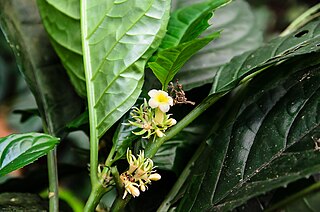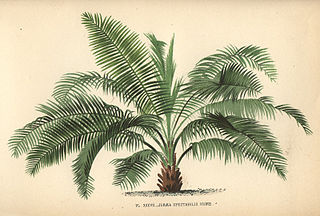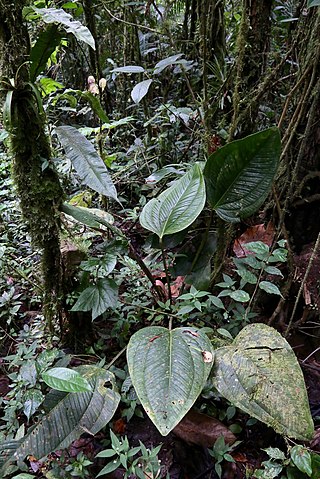
Iridaceae is a family of plants in order Asparagales, taking its name from the irises. It has a nearly global distribution, with 69 accepted genera with a total of c. 2500 species. It includes a number of economically important cultivated plants, such as species of Freesia, Gladiolus, and Crocus, as well as the crop saffron.

Phyllanthaceae is a family of flowering plants in the eudicot order Malpighiales. It is most closely related to the family Picrodendraceae.

Aleuritideae is a tribe of the subfamily Crotonoideae, under the family Euphorbiaceae. It comprises 6 subtribes and 14 genera.

Euphorbieae is a tribe of flowering plants of the family Euphorbiaceae. It comprises 3 subtribes and 5 genera. The 3 sub tribes are: Euphorbiinae, Neoguillauminiinae and Anthosteminae. The 5 genus general are: Argythamnia, Caperonia, Chiropetalum, Ditaxis and Chiropetalum.
Edgar Shannon Anderson was an American botanist. He introduced the term introgressive hybridization and his 1949 book of that title was an original and important contribution to botanical genetics. His work on the transfer and origin of adaptations through natural hybridization continues to be relevant.
Gloeospermum is a plant genus in the Violaceae family. It has been found in Central American, including Panama, and Ecuador.
Koilodepas calycinum is a species of plant in the family Euphorbiaceae. It is endemic to Tamil Nadu in India, and is endangered due to habitat loss. It grows as a small tree up to 6 metres (20 ft) tall, with elliptical or obovate leaves, at elevations of 670–830 metres (2,200–2,720 ft).

The Carlemanniaceae are a tropical East Asian and Southeast Asian family of subshrub to herbaceous perennial flowering plants with 2 genera. Older systems of plant taxonomy place the two genera, Carlemannia, and Silvianthus within the Caprifoliaceae or the Rubiaceae. The Angiosperm Phylogeny Group classification of 2003 places the group in the Lamiales, as a plant family more closely related to the Oleaceae than to the Caprifoliaceae.

Devia is a genus of plants in the family Iridaceae first described in 1990. It contains only one known species, Devia xeromorpha, endemic to the southwestern part of Cape Province in South Africa. The genus was named in honour of the South African botanist and academic, Miriam Phoebe de Vos.

Hosta yingeri is a perennial species of the genus Hosta. The species is rare and is only found in a few offshore islands along the southwestern coast of South Korea.

Cocoseae is a tribe of cocosoid palms of the family Arecaceae.

Susanne Sabine Renner is a German botanist. Until October 2020, she was a professor of biology at the Ludwig Maximilian University of Munich as well as director of the Botanische Staatssammlung München and the Botanischer Garten München-Nymphenburg. Since January 2021, she lives in Saint Louis, where she is an Honorary Professor of Biology at Washington University and a Research Associate at the Missouri Botanical Garden.
Ercilla is a genus of plants in the Phytolaccaceae family containing three species: Ercilla volubilis, Ercilla spicata, and Ercila syncarpellata.
Jeffrey Donald Palmer is a Distinguished Professor of Biology at Indiana University Bloomington.
Thomas Bernard Croat is an American botanist and plant collector, noteworthy as one of botanical history's "most prolific plant collectors". He has collected and described numerous species of plants, particularly in the family Araceae, in his career at the Missouri Botanical Garden.

Hoya retusa is a species of flowering plant in the genus Hoya native to India and the eastern Himalayas. It is an epiphyte. The plant's specific epithet retusa refers to the shape, with retuse meaning it has a rounded leaf apex with a notch. It grows in a trailing habit and the foliage is succulent. Hoya retusa grows in clumps with long stems hanging downwards. The leaves arise in clusters. The flowers are fragrant, star-shaped having creamy petals and red corona at center.
Irene Baker was an American botanist who collaborated with her husband Herbert G. Baker to research pollination biology, the composition of nectar and study its ecological, evolutionary and taxonomic qualities.
Anthurium jenmanii is a species of plant in the genus Anthurium. Growing as an epiphyte subshrub, it is native to South America from Trinidad and Tobago to Brazil. A member of the section Pachyneurium, and like related species it has a "birds nest" growth habit. It has a dark purple-black spadix and spathe, and produces red berries. In cultivation, it is commonly mistaken for Anthurium bonplandii subsp. guayanum, a related species.

Anthurium ernestii is a species of plant in the genus Anthurium native to South America. Found from southern Colombia to Peru and western Brazil, it typically grows below 500 metres (1,600 ft).

Anthurium ovatifolium is a species of plant in the genus Anthurium native to Colombia, Ecuador, and Peru. It grows in wet tropical habitats, and is a member of the section Digitinervium. Its species name refers to the oval shape of its leaves, and it can be distinguished from similar species like Anthurium lentii by its red berries.












